
The TIME magazine has ranked top 25 inventions that marked the year's cut as the most sophisticated technologies. The media organization has considered hundreds of inventions across the world to come to prepare the list.
It had selected important technologies including the floating lightbulb and the desktop DNA lab during the previous year. This year's innovative inventions include the first personal or social robot Jibo to the flexible polymer helmets which could protect footballers from head injuries.
Some of the important picks from the best inventions of 2017 published by the TIME are listed below:
Jibo
Jibo came as an innovation in the segment of Personal robots which could serve as an assistant and a friend to humans. The new personal robot is very different from its predecessors Amazon Echo and Google Home.
Jibo's big, round head and face could animate icons to convey emotions. It could speak, giggle and dance and would even turn its face to listen to its owner when it's called "Hey, Jibo."
This machine is a new phase of a complete humanin, which could react with expressive movements and responses. Jibo has been powered by face and voice recognition technology which helps it to remember people and build relationships with people it meets. It could say "Hi" to people who pass it and could interact with them.
eSight 3
eSight 3 could mimic eyesight to legally blind people. It could help a blind person to navigate through roads without the help of support canes and guide dogs. The instrument could aid blind persons to take part in various activities including sports, and other activities.
The instrument records high definition video and uses magnification, contrast and proprietary algorithms to enhance imagery of its users.
eSight 3 was launched in February 2017 at a prize of $9,995. Even though the prices are higher than the reach of ordinary people, it has been sold at cheaper rates than was previously said.
They are faster, lighter and have better zoom capabilities than previously thought.
Apple iPhone X
Apple iPhone X which is regarded as one of the world's most sophisticated smartphone comes up with advanced features including the screen that stretches from edge to edge, a processor optimized for augmented reality and the camera which would unlock by detecting user's face. Apple has removed its salient feature of all-purpose home-button while developing iPhone X.
Adidas Futurecraft 4D
Adidas has designed a super shoe named Futurecraft 4D which could help its users to run faster, pivot well and jump higher. The sneaker could be expertly tailored to fit the size and shape, impact type, cushioning and more.
According to reports, AI VanNoy who headed the project involving 3-D printing process said Adidas has to "look at every single square millimeter of a midsole and tune it from a performance standpoint." The researchers say that the shoe required weeks to get modified using traditional shoe-making methods.
The standardized version of the super shoe would be available in the stores from mid-December. The researchers believe that the Future 4Ds could be produced in stores in less than two hours using more advanced technologies.
Michelin Vision Concept
The Michelin tires have unveiled potential of a new airless tire technology which could reduce its wear and tear. The 3-D printing treads used in these tires would swap in and out to adjust to various conditions of the road. The tire has been designed to wrap around hurdles on the roads while it travels. The company believes that such complex tires could be developed in 20 years.
However, tires which use similar technology including airless designs and sensors which flag drivers during wearing down would be commonly used in a few years.
VICIS Zero1 helmet
Sam Browd, a pediatric neurosurgeon has developed hard, plastic helmets for football player using flexible polymers. The helmet would work like car bumpers and reduce the force of collision during the impact. The helmet is believed to reduce brain injuries caused due to accidents.









